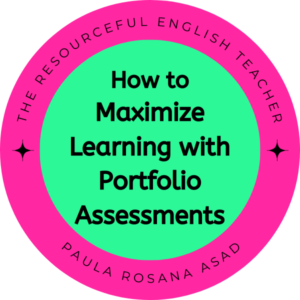How to Maximize Learning with Portfolio Assessments
Have you ever heard of the fantastic advantages of using portfolio assessment in class? For teachers looking for an effective way to measure and track student learning, portfolios can be an invaluable tool. Not only do they provide students with a clear view of their academic journey, but they also provide an opportunity for self-assessment and reflection. In this article, I’ll show you how portfolios can revolutionize your classroom!

What is a portfolio assessment?
A Portfolio Assessment is an organized compilation of student work that showcases their growth, skills, and abilities. In my EFL class, learners divide their portfolios into these skills: reading, writing, speaking, and listening. During each term, they use this portfolio to document their learning, goals, and reflections in those areas.
Benefits of portfolio assessments
- They provide students with evidence of progress. The students can compare a recent piece of work with an earlier one. As students judge their work using explicit criteria to identify strengths and weaknesses, they monitor their progress. Finally, they comment on how they improved over time and set new goals.
- They give teachers information about how to adjust their teaching. It is vital that students also understand the purpose of the portfolio, how it will be used to evaluate their work, and how grades will be determined.
- Portfolios can help teachers at the start of the year when they are still getting to know their students. By looking at a student portfolio, teachers can gain insight into the learner’s achievements from previous years and make more informed decisions in the present.
Thinking Journals
Adding a thinking journal to a student’s portfolio or some worksheets that promote self-assessment and reflection can go a long way in encouraging critical thinking. These materials can guide students in evaluating their own work, reflecting on their accomplishments as well as those areas for improvement. By offering support and guidance in this process, teachers can help students build valuable skills that will help them well into the future. Check out my “Thinking Journal” resource HERE!
Portfolio Conference
Once the teacher and students have each had the opportunity to evaluate the student’s work, they are ready to participate in a portfolio conference to discuss student progress. It is here where both students and teachers engage in collaborative assessment as part of the portfolio process. The teacher prepares their students for the portfolio conference by providing them with questions on a portfolio review guide. The teacher begins the conference by asking students to reflect on their own growth and goals regarding the learning objectives in different areas, like reading and writing.
Download my portfolio review guide HERE!

In conclusion, portfolio assessment provide teachers with a powerful tool to measure and track student learning in an organized and meaningful way. These portfolios are highly effective in fostering student self-reflection and growth and serve as a valuable source for teacher evaluation. By providing students with a close view of their academic journey and by encouraging them to take an active role in their own learning path, portfolios can revolutionize the classroom and empower students to reach their educational goals. So what do you think? Are you ready to use portfolio assessments in class?
Please reach out with any questions, I am happy to help!

